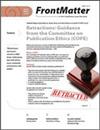Prescribed Fire and Changes in Annual Precipitation Alter Biocrust Cover in a Coastal Grassland
IF 0.5
4区 环境科学与生态学
Q4 BIODIVERSITY CONSERVATION
引用次数: 0
Abstract
Abstract. Prescribed fires are often used as a management tool in grasslands to promote the growth of desired plant species. These fires also impact other ecological communities where they occur. One ecological community that is often overlooked regarding fire is biological soil crusts (biocrusts). Biocrusts contain an assemblage of cyanobacteria, lichens, and bryophytes living on the soil surface and are important for nutrient cycling and soil stability. Here, we used prescribed burns in a California coastal grassland on San Clemente Island (SCI) to understand how fire impacts biocrust cover. Two sites were burned in a prescribed fire in 2012 and then again in 2017, and one site was burned in a wildfire in 2012 and a prescribed fire in 2017. We compared the percent cover of biocrusts in the burned and unburned plots in 2018 and 2019. However, precipitation differed drastically between sampling years; therefore, we also assessed the role of precipitation in moderating biocrust cover in the burned and unburned plots. In 2018 and 2019, one and two years after the last prescribed fire, the burned plots had more cyanobacterial biocrust cover than the controls. Annual precipitation had a negative effect on cyanobacterial biocrust cover, though lichen- and bryophyte-dominated biocrusts increased with increasing precipitation. The abundance of cyanobacterial biocrusts in the burned plots suggests either a level of recovery after the fire or the ability of biocrusts to withstand a grassland fire, though the effect is mediated by precipitation. Resumen. La quema prescrita se utiliza a menudo como una herramienta de gestión de pastizales para promover el crecimiento de las especies de plantas deseadas, pese a que estos incendios también tienen un impacto en otras comunidades ecológicas. Una comunidad ecológica que a menudo se pasa por alto con respecto a la quema son las costras biológicas del suelo (biocostras). Las biocostras contienen un conjunto de cianobacterias, líquenes y briófitas que viven en la superficie del suelo y son importantes para el ciclo de nutrientes y la estabilidad del suelo. Llevamos a cabo quemas prescritas en un pastizal costero de la isla de San Clemente (SCI) en California para comprender cómo el fuego afecta la cubierta de biocostra. Se quemaron dos sitios en un incendio prescrito en 2012 y luego nuevamente en 2017, uno de los sitios se quemó en un incendio forestal en 2012 y posteriormente un incendio prescrito en 2017. Comparamos el porcentaje de cobertura de biocostras en las parcelas quemadas y no quemadas en 2018 y 2019. Sin embargo, la precipitación difirió drásticamente entre los años de muestreo; por lo tanto, también evaluamos el papel de la precipitación en el crecimiento de la cobertura de biocostras en las parcelas quemadas y no quemadas. En 2018 y 2019, uno y dos años después de la última quema prescrita, las parcelas quemadas tenían mayor cobertura de biocostras de cianobacterias que la de los controles. La precipitación anual tuvo un efecto negativo en la cubierta de biocostras de cianobacterias, aunque las biocostras dominadas por líquenes y briófitas aumentaron con la precipitación. La abundancia de biocostras de cianobacterias en las parcelas quemadas sugiere un nivel de recuperación después del fuego o la capacidad de las biocostras para resistir un incendio de pastizales, no obstante, dicho efecto depende de la precipitación.明火和年降水量的变化改变了沿海草地的生物覆盖率
摘要预设火灾通常被用作草原管理工具,以促进所需植物物种的生长。这些火灾也会对发生火灾的其他生态群落产生影响。其中一个经常被忽视的生态群落是生物土壤结壳(生物结壳)。生物结壳包含生活在土壤表面的蓝藻、地衣和苔藓植物,对养分循环和土壤稳定性非常重要。在此,我们在加利福尼亚州圣克莱门特岛(SCI)的沿海草地上使用了规定火烧,以了解火对生物簇覆盖的影响。两个地点分别于 2012 年和 2017 年进行了一次规定火烧,一个地点分别于 2012 年和 2017 年进行了一次野火烧。我们比较了 2018 年和 2019 年烧毁地块和未烧毁地块的生物覆盖率。然而,不同采样年份的降水量差异很大;因此,我们还评估了降水量在减缓烧毁地块和未烧毁地块的生物簇覆盖率方面所起的作用。在 2018 年和 2019 年,即最后一次规定火烧后的一年和两年,烧毁地块的蓝藻生物簇覆盖率高于对照地块。年降水量对蓝藻生物簇覆盖率有负面影响,但地衣和苔藓植物为主的生物簇覆盖率会随着降水量的增加而增加。烧毁地块中蓝藻生物簇的丰富程度表明,火灾后蓝藻生物簇的恢复程度或生物簇抵御草原火灾的能力,尽管这种影响受降水的影响。总结。预烧通常被用作草原管理工具,以促进所需植物物种的生长,但这些火也会影响其他生态群落。在焚烧方面经常被忽视的一个生态群落是生物土壤结壳(生物结壳)。生物结壳包含生活在土壤表面的蓝藻、地衣和苔藓植物,对养分循环和土壤稳定性非常重要。我们在加利福尼亚州圣克莱门特岛(SCI)的沿海草地上进行了规定火烧,以了解火对生物簇覆盖的影响。两个地点分别于 2012 年和 2017 年进行了规定火烧,一个地点于 2012 年进行了野火烧,然后于 2017 年进行了规定火烧。我们比较了 2018 年和 2019 年烧毁地块和未烧毁地块的生物覆盖率。然而,不同采样年份的降水量差异很大;因此,我们还评估了降水量对已烧毁和未烧毁地块生物锈覆盖生长的作用。2018 年和 2019 年,即最后一次规定焚烧后的一年和两年,焚烧地块的蓝藻生物簇覆盖率高于对照地块。年降水量对蓝藻生物簇覆盖率有负面影响,但地衣和苔藓植物为主的生物簇覆盖率会随着降水量的增加而增加。烧毁地块中蓝藻生物簇的丰富程度表明了火灾后的恢复程度或生物簇抵御草原火灾的能力,但这种影响取决于降水量。
本文章由计算机程序翻译,如有差异,请以英文原文为准。
求助全文
约1分钟内获得全文
求助全文
来源期刊

Western North American Naturalist
环境科学-生态学
CiteScore
0.90
自引率
16.70%
发文量
39
审稿时长
>36 weeks
期刊介绍:
The Western North American Naturalist places neither restriction nor preference on manuscripts within the disciplines of the biological sciences. Each issue treats diverse taxa from the perspectives of various disciplines (e.g., ecology, population dynamics, behavior, systematics, anatomy, and physiology).
 求助内容:
求助内容: 应助结果提醒方式:
应助结果提醒方式:


